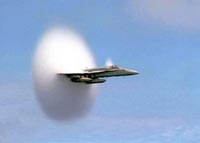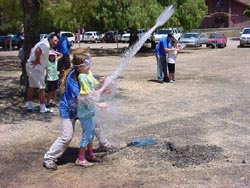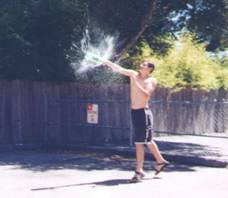Rockets shoot skyward with massive amounts of thrust, produced by chemical reaction or air pressure. Scientists create the thrust force by shoving a lot of gas (either air itself, or the gas left over from the combustion of a propellant) out small exit nozzles. This experiment and activity is for Grades 9-12.
According to the universal laws of motion, for every action, there is equal and opposite reaction. If flames shoot out of the rocket downwards, the rocket itself will soar upwards. It’s the same thing if you blow up a balloon and let it go—the air inside the balloon goes to the left, and the balloon zips off to the right (at least, initially, until the balloon neck turns into a thrust-vectored nozzle, but don’t be concerned about that just now).
[am4show have=’p8;p9;p11;p38;p92;’ guest_error=’Guest error message’ user_error=’User error message’ ]
A rocket has a few parts different from an airplane. One of the main differences is the absence of wings. Rockets utilize fins, which help steer the rocket, while airplanes use wings to generate lift. Rocket fins are more like the rudder of an airplane than the wings.
Another difference is the how rockets get their speed. Airplanes generate thrust from a rotating blade, whereas rockets get their movement by squeezing down a high-energy gaseous flow and squeezing it out a tiny exit hole.
If you’ve ever used a garden hose, you already know how to make the water stream out faster by placing your thumb over the end of the hose. You’re decreasing the amount of area the water has to exit the hose, but there’s still the same amount of water flowing out, so the water compensates by increasing its velocity. This is the secret to converging rocket nozzles—squeeze the flow down and out a small exit hole to increase velocity.
There comes a point, however, when you can’t get any more speed out of the gas, no matter how much you squeeze it down. This is called “choking” the flow. When you get to this point, the gas is traveling at the speed of sound (around 700 mph, or Mach 1). Scientists found that if they gradually un-squeeze the flow in this choked state, the flow speed actually continues to increase. This is how we get rockets to move at supersonic speeds or above Mach 1.
 This image (at left) is a real picture of an aircraft as it breaks the sound barrier. This aircraft is passing the speed at which sounds travel. The white cloud you see in the photo is related to the shock waves that are forming around the craft as it moves into supersonic speeds. Because the aircraft is moving through air, which is a gas, the gas can compress and results in a shock wave. You can think of a shock wave as big pressure front. In this photo, the pressure is condensing water vapor in the air, hence the cloud. There are lots of things on earth that break the sound barrier – bullets and bullwhips, for example. The loud crack from a whip is the tip zipping faster than the speed of sound.
This image (at left) is a real picture of an aircraft as it breaks the sound barrier. This aircraft is passing the speed at which sounds travel. The white cloud you see in the photo is related to the shock waves that are forming around the craft as it moves into supersonic speeds. Because the aircraft is moving through air, which is a gas, the gas can compress and results in a shock wave. You can think of a shock wave as big pressure front. In this photo, the pressure is condensing water vapor in the air, hence the cloud. There are lots of things on earth that break the sound barrier – bullets and bullwhips, for example. The loud crack from a whip is the tip zipping faster than the speed of sound.
The rockets we’re about to build get their thrust by generating enough pressure and releasing that pressure very quickly. Here’s what you need to do:
[amprotect=3,4,8,10,18,20,30,32,37,41,44,15,unit2p,52,grade8c]
You’ll need to find:
- empty 2L soda bottle
- razor
- car tire valve
- bicycle pump
Modify an empty soda bottle into a rocket that launches from your hand! Important: DO NOT USE water bottles as they will burst. You MUST use a bottle that was made to hold contents under pressure.
Clamp the soda bottle cap in a vice. Using a razor blade, strip threads from the cap until you can untwist the cap completely from the bottle with one wrist movement. You’ll have to cut off approximately one full turn of threads from open end, which will make it easier to get the cap off quickly without allowing too much air pressure to leak out. It also makes this experiment more dangerous and prone to accidents as now the cap will comes off a lot easier. Be careful!
Drill a hole that matches the size of the car tire valve into the center of the cap, again using the vice to hold it still. A ½-inch spade bit works best. Next insert the valve through cap so when it’s screwed on, you can easily pressurize the bottle with a bicycle pump. To the bottle, add water , screw on the valve-cap, and pump up the pressure using the bicycle pump or air compressor until the bottle feels rock-solid.
NOTE: Bottles tend to burst above 70 psi and after extended use, so replace the bottles after 7-10 shots. As they get banged around on landing, they start forming fissures that lead to bursting under pressure. If you are using an air compressor rather than a bicycle pump, be sure to keep your air compressor set to a maximum of 70 psi.
 Hold the bottle bottoms-up at an angle, grasp the cap, and begin to untwist slowly… until the water begins to drip out and leaks like a faucet. Now untwist the cap fully in one motion, and the bottle will fly a hundred feet or more, leaving you drenched and awed. Make sure you’ve got about a football field-sized launch area.
Hold the bottle bottoms-up at an angle, grasp the cap, and begin to untwist slowly… until the water begins to drip out and leaks like a faucet. Now untwist the cap fully in one motion, and the bottle will fly a hundred feet or more, leaving you drenched and awed. Make sure you’ve got about a football field-sized launch area.
What’s happening?
This rocket uses HIGH pressure to soar skyward. Think of a balloon; when you release the end of a balloon, the air inside the balloon travels one direction and the balloon zooms in the opposite direction (initially, anyway). The Water Rocket shoots water in one direction (toward you) and launches in the other (away from you).
Why is there water in the rocket?
The water is in there to provide you with both a visual of what’s going on (when the water leaks out, you know it’s time to untwist the cap FAST), as well as giving you a time-delay to get the cap off. Try launching it without water (just pressurize the bottle) and see if you’re fast enough to launch it.
 Troubleshooting: The first time kids do this experiment, they are often so surprised it works that they drop the bottle on the ground OR they grasp it so tight that they forget to let the rocket go. With practice, you will be able to launch them consistently skyward.
Troubleshooting: The first time kids do this experiment, they are often so surprised it works that they drop the bottle on the ground OR they grasp it so tight that they forget to let the rocket go. With practice, you will be able to launch them consistently skyward.
ALWAYS USE SAFETY GOGGLES or a FACE SHIELD!
Be sure to transport the charged bottle with the valve-side down, in case the valve tears free from the bottle.
How far did your rocket go? Tell us in the comment field! (DON’T FORGET YOUR SAFETY GOGGLES!!)
[/amprotect]
[/am4show]

